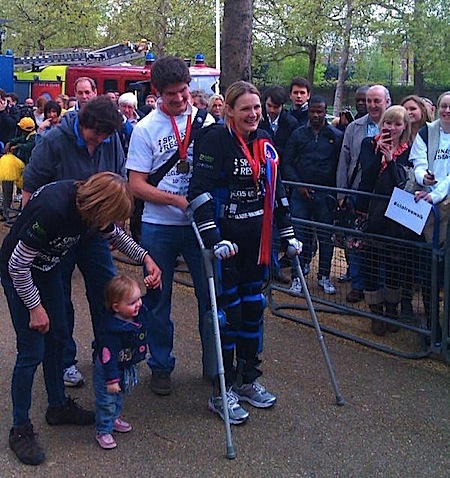Science Fiction
Dictionary
A B C D E F G H I J K L M N O P Q R S T U V W X Y Z
Paralyzed Woman In Robotic Exoskeleton Finishes Marathon

Can a paralyzed person run a marathon? A London woman wanted to find out, using a ReWalk robotic exoskeleton.

(Claire Lomas raises funds for spinal cord injury research)
Claire Lomas suffered a T4 spinal injury in a 2007 horse riding accident that left her paralyzed from the chest down. In 2012, she completed the London Marathon. What happened in between was the development of a robotic suit that let her tackle the challenge on her own two legs.It took 17 days for the 32-year-old resident of Leicestershire, England, to cross the finish line. Her motivation for the marathon was to raise funds for spinal cord injury research. So far, she has raised nearly $200,000.
(Claire Lomas practices with ReWalk)
I remember when exoskeletons were the stuff of science fiction. Here's an excerpt from Fritz Leiber's 1968 novel A Specter is Haunting Texas:
This truly magnificent, romantically handsome, rather lean man was standing on two corrugated-soled titanium footplates. From the outer edge of each rose a narrow titanium T-beam that followed the line of his leg, with a joint (locked now) at the knee, up to another joint with a titanium pelvic girdle and shallow belly support. From the back of this girdle a T-spine rose to support a shoulder yoke and rib cage, all of the same metal. The rib cage was artistically slotted to save weight, so that curving strips followed the line of each of his very prominent ribs.
(Read more about Leiber's titanium exoskeleton
Via CNEt; also, you can contribute at Claire Lomas' website.
Scroll down for more stories in the same category. (Story submitted 5/12/2012)
Follow this kind of news @Technovelgy.| Email | RSS | Blog It | Stumble | del.icio.us | Digg | Reddit |
Would
you like to contribute a story tip?
It's easy:
Get the URL of the story, and the related sf author, and add
it here.
Comment/Join discussion ( 0 )
Related News Stories - (" Medical ")
Brain Implant Is Able To Capture Your Inner Dialogue
'So you see, you can hide nothing from me.'
'Pregnancy Humanoids' From China Replace Moms
'A great many of these synthetic babies were made...' - David H. Keller, 1928.
Bacteria Turns Plastic Into Pain Relief? That Gives Me An Idea.
'I guess there's nobody round this table who doesn't have a Crosswell [tapeworm] working for him in the small intestine.'
Heart Patches Grown In The Lab Repair Hearts
I'm hoping that this procedure becomes a normal part of medical practice!
Technovelgy (that's tech-novel-gee!) is devoted to the creative science inventions and ideas of sf authors. Look for the Invention Category that interests you, the Glossary, the Invention Timeline, or see what's New.
Science Fiction
Timeline
1600-1899
1900-1939
1940's 1950's
1960's 1970's
1980's 1990's
2000's 2010's
Current News
iPhone Air Fulfils Jobs' Promise From 2007 - A Giant Screen!
'... oblongs were all over the floor and surfaces.'
ChatGPT Now Participates in Group Chats
'...the city was their laboratory in human psychology.'
iPhone Pocket All Sold Out!
'A long, strong, slender net...'
Did The Yautja Have These First?
What a marvel of ingenuity the little device was!
Jetson ONE Air Races Begin, Can Air Polo Be Far Behind?
'If you're one of those rarities who haven't attended a rocket-polo "carnage", let me tell you it's a colorful affair.'
Will Space Stations Have Large Interior Spaces Again?
'They filed clumsily into the battleroom, like children in a swimming pool for the first time, clinging to the handholds along the side.'
Mornine Sales Robot
'Robot-salesmen were everywhere, gesturing...'
Bipedal Robot Floats Gently While Walking
'a walking balloon proceeded with long strides of its aluminum legs...'
Musk Idea Of Cars Talking To Each Other Predicted 70 Years Ago
'My cars talk to one another.'
Elegant Bivouac Shelter Produces Water And Electricity
'There was nowhere on the planet where science and technology could not provide one with a comfortable home...'
X-Control Janus-1 A Suitcase Aircraft
'You will notice that it... fits the suitcase nicely.'
'AI Assistants' Are Actually Less Reliable For News
'Most men updated their PIP on New Year's Day...'
YES!! Remote Teleoperated Robots predicted by Technovelgy!
'...a misshapen, many-tentacled thing about twice the size of a man.'
Will Robots Ever Fold Landry?
Where have you gone, Mrs. Robinson?
Will AIs Give Better Results If You're Rude To Them?
'I said, "Listen up, motherf*cker.'
Cybertruck Robotic Arm F10 Drone Launch!
Drone away!
